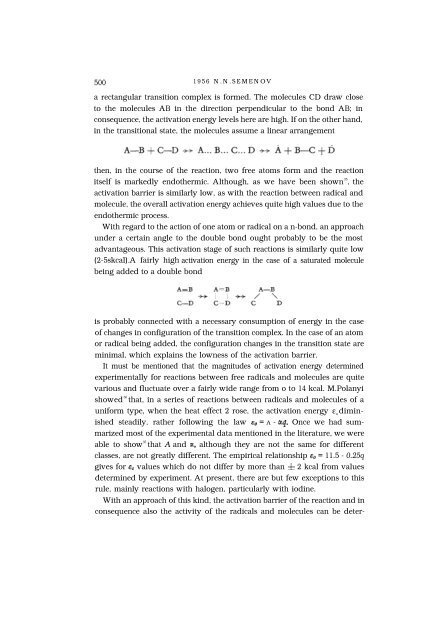Nikolai N. Semenov - Nobel Lecture - Nobelprize.org
Nikolai N. Semenov - Nobel Lecture - Nobelprize.org
Nikolai N. Semenov - Nobel Lecture - Nobelprize.org
Create successful ePaper yourself
Turn your PDF publications into a flip-book with our unique Google optimized e-Paper software.
500 1956 N.N.SEMENOV<br />
a rectangular transition complex is formed. The molecules CD draw close<br />
to the molecules AB in the direction perpendicular to the bond AB; in<br />
consequence, the activation energy levels here are high. If on the other hand,<br />
in the transitional state, the molecules assume a linear arrangement<br />
then, in the course of the reaction, two free atoms form and the reaction<br />
itself is markedly endothermic. Although, as we have been shown 35 , the<br />
activation barrier is similarly low, as with the reaction between radical and<br />
molecule, the overall activation energy achieves quite high values due to the<br />
endothermic process.<br />
With regard to the action of one atom or radical on a n-bond, an approach<br />
under a certain angle to the double bond ought probably to be the most<br />
advantageous. This activation stage of such reactions is similarly quite low<br />
(2-5skcal).A fairly high activation energy in the case of a saturated molecule<br />
being added to a double bond<br />
is probably connected with a necessary consumption of energy in the case<br />
of changes in configuration of the transition complex. In the case of an atom<br />
or radical being added, the configuration changes in the transition state are<br />
minimal, which explains the lowness of the activation barrier.<br />
It must be mentioned that the magnitudes of activation energy determined<br />
experimentally for reactions between free radicals and molecules are quite<br />
various and fluctuate over a fairly wide range from o to 14 kcal. M.Polanyi<br />
showed 36 that, in a series of reactions between radicals and molecules of a<br />
uniform type, when the heat effect 2 rose, the activation energy ε ο<br />
diminished<br />
steadily, rather following the law co = A - aq. Once we had summarized<br />
most of the experimental data mentioned in the literature, we were<br />
able to show 35 that A and Q, although they are not the same for different<br />
classes, are not greatly different. The empirical relationship so = 11.5 - 0.25q<br />
gives for so values which do not differ by more than & 2 kcal from values<br />
determined by experiment. At present, there are but few exceptions to this<br />
rule, mainly reactions with halogen, particularly with iodine.<br />
With an approach of this kind, the activation barrier of the reaction and in<br />
consequence also the activity of the radicals and molecules can be deter-
















